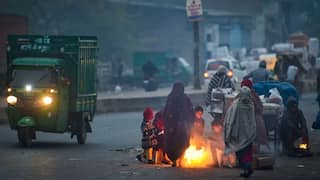Explorer
The Ayodhya Verdict: What Does it Mean for Hindus?
What is at stake for Hindus is, however, something yet more profound. Let us consider briefly some implications, each of which lends itself to much greater explication.

People watch ABP News' live telecast on a mobile phone about the Supreme Court verdict on a disputed religious site, in Ayodhya on November 9, 2019. (PIC/AFP)
The Supreme Court verdict of November 9th on the Ramjanmabhoomi-Babri Masjid title dispute case, resolved unanimously in favor of the Hindu parties, has deservedly come in for much criticism by Muslims, liberals, and many others who remain anguished over the diminishing prospects of secularism and the future of the Republic. It remains unnecessary to recapitulate everything that may be found wanting or contradictory in the court’s judgment, though some aspects of the ruling will surely continue to puzzle those who have more than a rudimentary understanding of the issues at the heart of the dispute. Just how did the Supreme Court, for example, arrive at the view that “on a balance of probabilities, the evidence in respect of the possessory claim of the Hindus to the composite whole of the disputed property stands on a better footing than the evidence adduced by the Muslims”? The reasoning here seems to be perfunctory, to say the least: since the Court admits that Muslims did offer worship from 1857 until 1949, it must have some account of what purpose the Babri Masjid served for the 300 years preceding 1857. It doesn’t.
The Supreme Court ruling is, in spirit, contradictory and even disturbing in yet more fundamental ways. The Court went so far as to say that “the exclusion of the Muslims from worship and possession took place on the intervening night between 22/23 December 1949 when the mosque was desecrated by the installation of Hindu idols. The ouster of the Muslims on that occasion was not through any lawful authority but through an act which was calculated to deprive them of their place of worship.” Similarly, the court condemned in clear and unequivocal terms the destruction of the mosque on 6 December 1992 as an “egregious violation of the law”. Why, then, should law-breakers and the perpetrators of violence be rewarded rather than penalized, which is doubtless what appears to have happened in this case? Those who have come out in defense of the judgment have of course argued that the Court only weighed in on the matter of whether the Muslims or the Hindus had a better claim to the land, but this reasoning cannot remotely be reassuring to those who would like the nation to contend with the one indisputable fact: a mosque that once stood there for almost five centuries is no longer in existence. The Court’s tacit uneasiness with its own judgment is conveyed in the ringing declaration that “the Muslims have been wrongly deprived of a mosque which has been constructed well over 450 years ago.”
ALSO READ: The Lynching Of Jawahar Lal Nehru University
It is perhaps for this reason, among others, that the court’s judgment has also come in for some praise, and not only by those who one might expect to be jubilant at the outcome: here the argument seems to be that the Supreme Court had to deal with a very difficult and potentially explosive situation, and that it made the best of an altogether bad situation. The acknowledgment by the court of the harrowing loss of the mosque and the harm to the Muslim community may be read both as an act of contrition and as an exemplary demonstration of the delicate balancing act that judicial bodies in India may have to perform at a time when a Hindu nationalist party controls nearly all the levers of power. The recent statement signed by some 100 Muslims, among them prominent artists, activists, and writers, as well as farmers, engineering students, and home-makers, urging their fellow Muslims to refrain from further litigation cannot of course be construed as signaling their agreement with the Supreme Court’s decision, but it acknowledges the brute fact that “keeping the Ayodhya dispute will harm, and not help, Indian Muslims.” Their note makes for painful reading, reminding Muslims that every iteration of the dispute has led to the loss of Muslim lives: “Have we not learnt through bitter experience that in any communal conflict, it is the poor Muslim who pays the price?”
Many commentators of liberal and secular disposition have thus sought to consider the implications of the Supreme Court verdict for the future of the Muslim community. But there is another equally critical, and little considered, question: what does it mean for Hindus? The answer seems too obvious to most commentators to even require mention. The project of building a Hindu rashtra, on this view, has received a massive boost. Both the supporters and critics of the court verdict are in agreement that the transformation of India from a secular polity—to the extent that it has been one—to a Hindu nationalist state will be witnessed in most domains of life, from educational and cultural institutions to cultural norms, altered patterns of social intercourse, and claims on the public sphere. The process of altering textbooks to suit new narratives of Hindu glory has been ongoing for many years; it will almost certainly receive more state funding. The secularists will deplore the increasing intolerance on part of Hindus, while the nationalists will argue that, for the first time in a millennium, the Hindu can finally feel at ease in the only country which he can justly call his own. The supposed “tolerance” of the Hindus will, on the secular-liberal view, be put to a severe test and they are almost certainly bound to fail the test; from the standpoint of the Hindu nationalist, Hindus will no longer feel ashamed to own up to their religion and the entire world will be compelled to recognize India for what it is, namely a country that in its origins and soul is fundamentally Hindu.
What is at stake for Hindus is, however, something yet more profound. Let us consider briefly some implications, each of which lends itself to much greater explication. First, Hinduism, as even those who are not Hindus recognize, may reasonably be said to be more accommodating of diversity than any other faith in the world. Some who call themselves Hindus do nothing more than read the Gita, the Ramayana, the Bhagavatam, the Upanishads, or one or more of hundreds of texts; others visit temples; and yet others do neither but may only meditate, perform seva, or undertake a quiet form of puja at home before their ishta devata. One may think of a thousand other scenarios and we would not still be even remotely close to approximating the fecundity and diversity of religious practices that have been gathered under the umbrella of Hinduism. Yet there appears to be a gravitational shift towards “temple Hinduism”, a growing intolerance not merely, as right-minded people would argue, against Muslims and Dalits but rather within the faith itself towards adherents of other practices and conceptions of Hinduism. Temple Hinduism may be viewed as a mode of establishing communality, but it is also a public display of one’s religious adherence and a tacit declaration of the strength of numbers. The question is whether the Supreme Court verdict does not feed into this worldview of temple Hinduism.
OPINION: The Phenomenon Of Bhagat Singh
Secondly, if one considers that the entire Ayodhya movement has been a loud, aggressive, and garrulous enterprise, is it not the case that the entire tenor of what it means to be a Hindu has changed radically over the last several decades? Hinduism has never, as I have already suggested, been one thing; nevertheless, the Hinduism that some of us grew up with was the religion of the sants and bhakts, of sweet and often mesmerizing devotional songs, and of the quiet devotion of one’s mother (and sometimes father) at home. The modern phase of the Ayodhya movement, by contrast, started with the rath yatra in 1990, undertaken by Advani across the country in an air-conditioned Toyota retrofitted as a chariot. It was nothing if not a raucous affair, orchestrated as a spectacle and designed for the media; much the same can be said of the various other stages of this movement, from loud displays of their devotion to the cause by kar sevaks to the very visible, media-driven, and almost outlandish destruction of the Babri Masjid in 1992. In its verdict, the Supreme Court, which does not appear to have given much thought to this matter, and which in any case would have been outside of its purview, has perhaps inadvertently surrendered to this loud, restless, and even strident form of Hinduism.
BLOG: Behind The WhatsApp Hack Mystery
Thirdly, however unpalatable such a proposition may be to especially middle-class Hindus, those who might be described as the most likely supporters of an aggressive Hindu nationalism, Hinduism is a religion of mythos rather than of history. Its most remarkable strength has been that it is singularly devoid of a historical founder, just as it has never had any “scripture”—a word that must always be used advisedly when speaking of Hinduism, and that here I use with extreme reservation—that may be construed as the equivalent of the Quran or the Bible. No “Hindu” until comparatively recent times was ever bothered by the fact that neither Rama nor Krishna could be viewed as historical figures in the vein of Jesus or Muhammad. But history has, alas, become the master narrative of our modernity, and in the verdict of the Supreme Court we see the tragic and nearly always destructive tethering of history to the telos of the nation-state. Hindus may have won a temple and, as they think, avenged their “humiliation” and gained back their pride, but if the nation continues along this trajectory they would have lost their very religion.
(Vinay Lal is a writer, blogger, cultural critic, and Professor of History at UCLA)
Disclaimer: The opinions, beliefs and views expressed by the various authors and forum participants on this website are personal and do not reflect the opinions, beliefs and views of ABP News Network Pvt Ltd.
Follow Blog News on ABP Live for more latest stories and trending topics. Watch breaking news and top headlines online on ABP News LIVE TV
View More


























